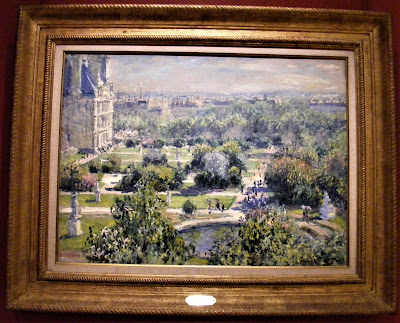 |
| Pissarro - Déchargement de bois, Quai de la Bourse |
Paris has 130 museums. In addition to the permanent collection of each, most also have temporary shows that change two or three times a year.
So when I’m here, I have a long list of shows I want to see. This time I have eight or nine to fit into four weeks. I’ve already done the Ateliers Mythiques at the Musée de Montmartre and Mucha at the Musée du Luxembourg. Today it’s the turn of the Collections Privées at the Marmottan. And with an old friend.
 |
| Caillebotte - Pont de l'Europe |
The Marmottan-Monet Museum is a perfect place for an intimate show. Originally, it was the large home, quaintly called the “hunting lodge”, of the Duke of Valmy. (I’m presuming he hunted in the Bois de Boulogne a mere block away.) The lodge was later purchased by Monsieur Marmottan, whose son then gave it and his art collection to the Paris Academy of Beaux-Arts. For many years that was the museum’s name, and it housed a lot of Impressionist art, including Monet. Which is why decades later Claude Monet’s son Michel chose to bequeath his own collection of his father’s works to the museum... and a third M was added to the name.
The permanent collections rule on the basement and upstairs levels. The ground floor houses the temporary shows, as well as rooms that have some of the original furniture, period pieces to delight those interested.
Me, I’ve come for the Collections Privées, Impressionist art owned by private individuals, artworks rarely - if ever - seen outside of these individuals’ four walls.
Sometimes the owner of the painting was indicated, but usually not. People don’t always want burglars to know what’s hanging in their homes. The word “Monaco” arose often, but who knows whether it’s Prince Albert, one of his sisters, or any of the über-rich people who have paid for a residence in that tax-free principality on the Mediterranean. Two names came up often. One is American, the son of a grocer who hit it rich in money management: Scott Black. (His wife Isabelle was gallantly also named as co-owner.) The other, Juan Antonio Pérez Simón, is a Spaniard who has lived most of his life in Mexico, made his money in telecommunications, and loves to loan his artworks out, which he’s done here. French magazine Paris Match says his art collection is the largest in private hands in the world.
 |
| Monet - Tuileries, 1876 |
But on to the works themselves.
The name Impressionism came from a painting by Monet shown in the first show ever by artists of this genre (in 1874). Monet called it Impression, soleil levant (Impression, Sunrise). A scoffing art critic picked up on that and said that none of the paintings in the show were real art, but only just impressions. The term stuck. (That painting is downstairs here at the Marmottan.)
Impressionism is all about light. How it refracts. How it reflects off things. How it can transform a color. One of the best demonstrations of this is when the artist represents dappled light, scenes with light and shadow. One canvas by Caillebotte demonstrated this: Le Jardin du Petit Gennevilliers. Obviously not the center feature of the painting, three women sit off in a corner, talking in the sun. The focus, so to speak, is on the shadows cast by the tall trees and on the walk and flowerbed, and how the fruit tree stands out against the darkness in the background. The shadow takes up a good third of the canvas, the third that’s front and center. The year being 1889, the work is still somewhat traditional, as paintings were, pre-photography. It’s a scene you now might snap with your smartphone, except broken down by... light.
 |
| Toulouse-Lautrec - La Blanchisseuse |
Another thing that fascinated the Impressionists, something still fairly new in the world of that time, was the steam engine. The constant morphing of the rising steam was as challenging to try to capture on canvas as was light. Which is why so many artists set up their easels near Paris’s Gare St. Lazare train station and on the Pont de l’Europe bridge spanning the tracks. Pissarro captured it well in another setting: the docks, where boats wait to be loaded or unloaded. The river gave him the additional opportunity to interpret light on the water, as well as in the sky. As it was painted in 1898, Impressionism had already moved on a bit from a softer version of photographic depiction to something more personal, a step or two farther from reality.
 |
| Théo van Rysselberghe - Regatta |
 |
| Vlaminck, by Derain |
There were also a few pieces of sculpture in the show. One was a chillingly striking head of St. John the Baptist by Rodin. I saw one such head once in a church in Madaba, Jordan. What’s striking here, in addition to Rodin’s mastery of the chisel, is the coldness of the white marble. You’re sure he’s well and truly dead. In contrast to that, there’s a child’s head by Rodin’s student - and paramour - Camille Claudel. It’s displayed with a mirror behind it so you can stare into the child’s eyes yet see the loosely braided hair flowing down her back. Head slightly tilted up, she seems to be waiting for something, expecting something. The artist leaves it to us to imagine what.
There were many more artworks in this show. But these were the ones that called out to me the most.
And most of them will never be seen publicly again. Unless it’s at Sotheby’s or Christie's.
 |
| Claude Monet, by Philippe Garel |
A voyage from Impressionist to Fauve
Musée Marmottan Monet
2 rue Louis-Boilly; 16è
Métro: La Muette
01.44.96.50.33
Until February 10, 2019
T-Sun 10-6 / Th 10-9
Closed Mondays
11 & 7.50 €










